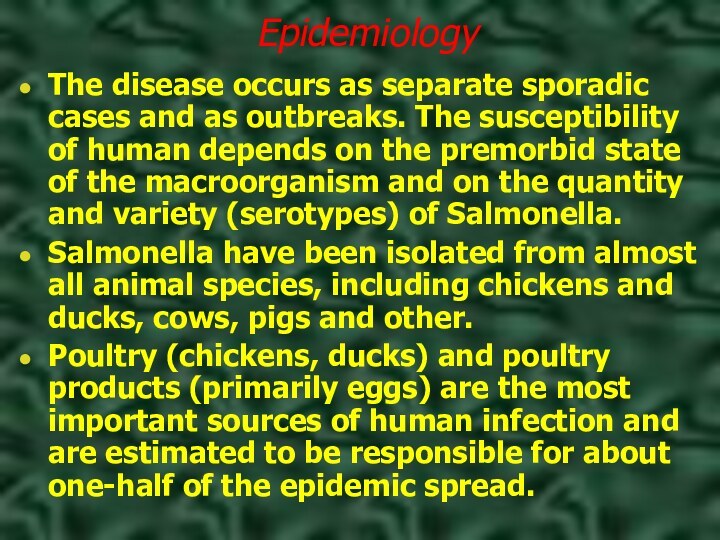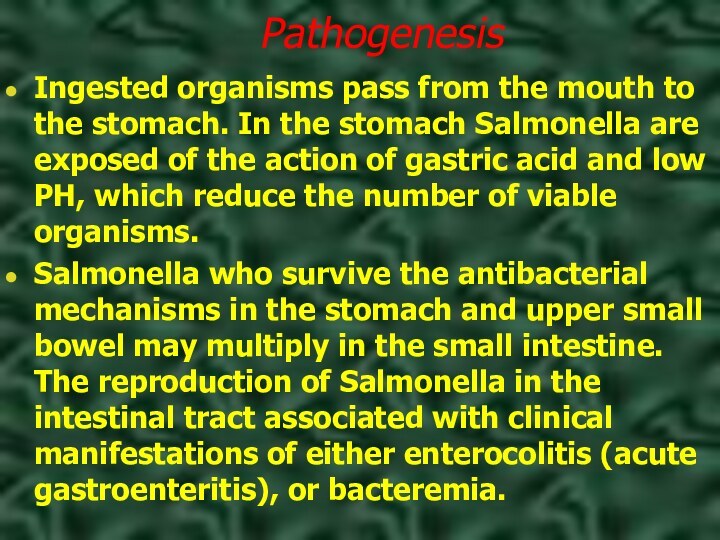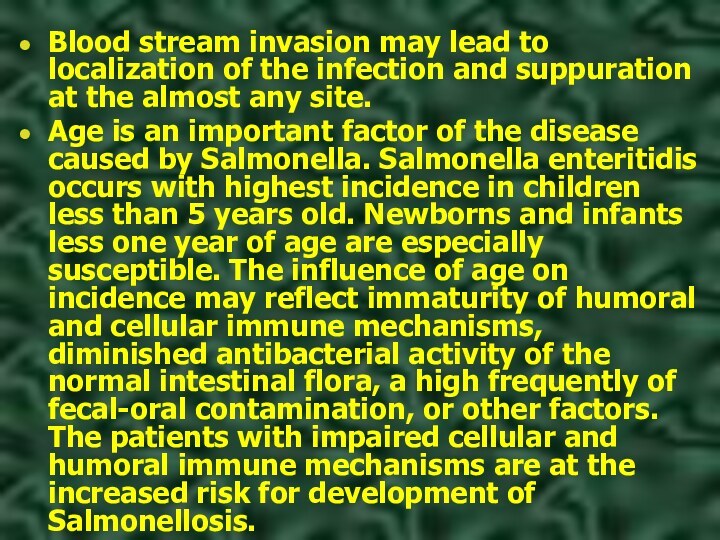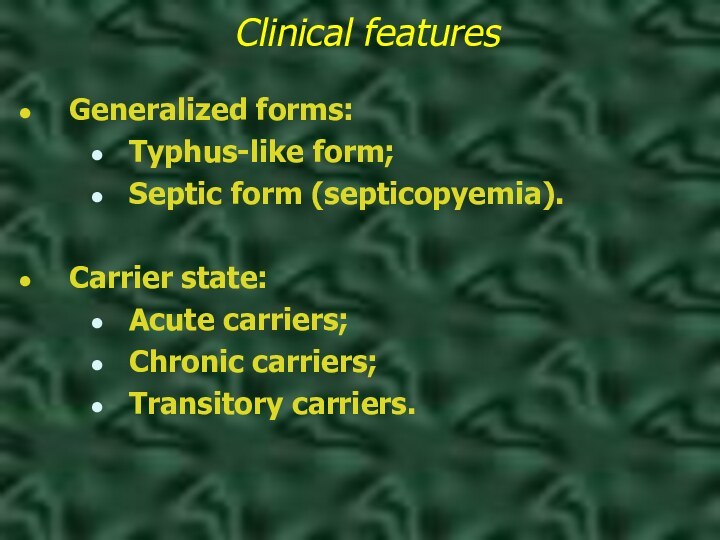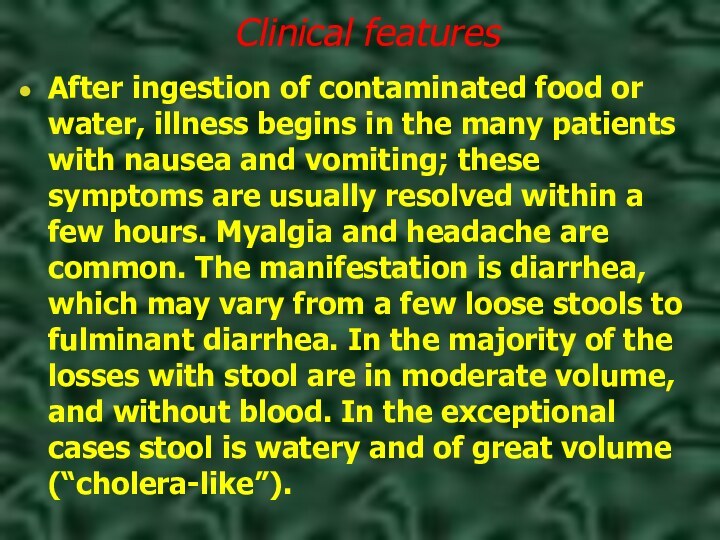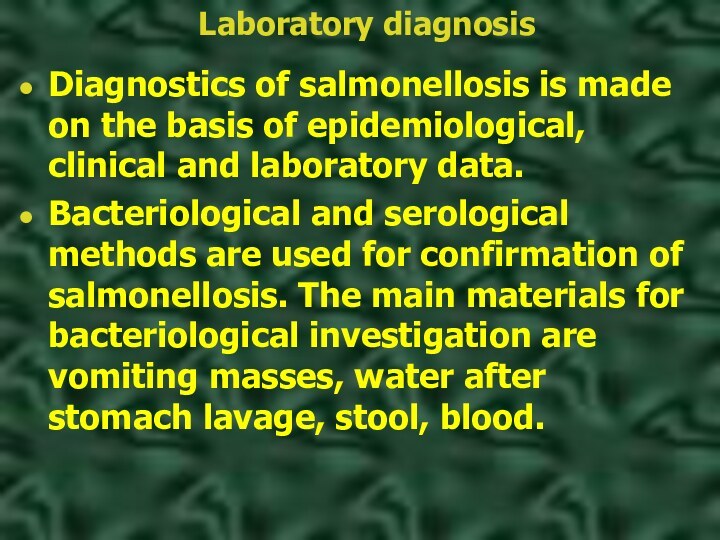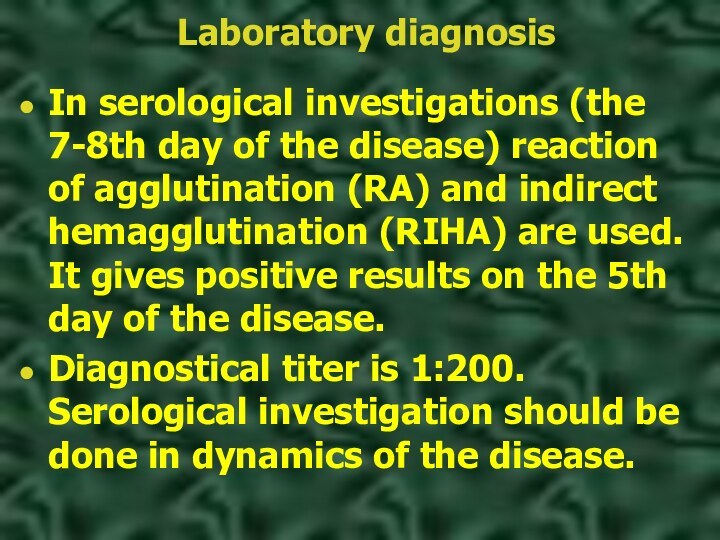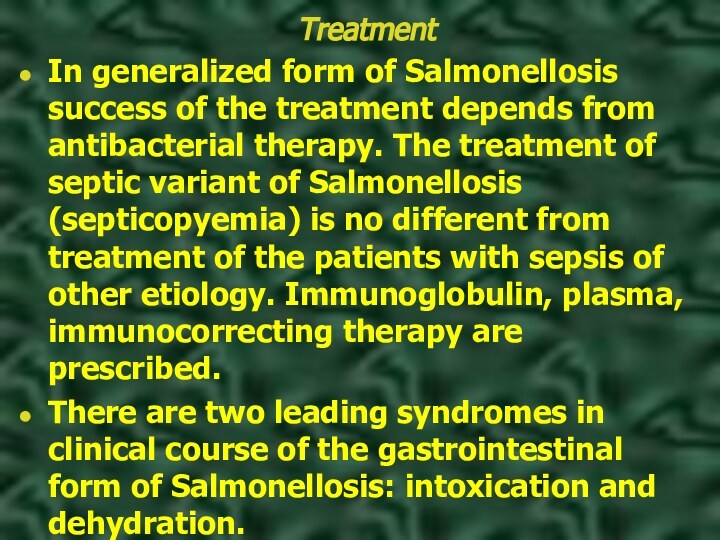Слайд 2
The term Salmonellosis unites the large group of
the diseases, caused by multiply serotypes of bacteria from
the genus Salmonella.
There are well over 2000 different antigenic types of salmonella.
Слайд 3
Salmonellosis is a disease of animals and humans.
It is characterized by a considerable damage of the
gastrointestinal tract, and more rarely by typhus-like or septicopyemic course.
Слайд 4
Etiology
There are well over 2000 different antigenic types
of salmonella.
They were originally classified as separate species, but
it is now generally accepted that they represent serotypes of a single species, Salmonella enterica.
Various subspecies are recognized, but most of the serotypes that infect mammals are found in a subspecies also designated enterica.
Слайд 5
The full correct designation is, for example: S.
enterica subspecies enterica serotype Enteritidis, but this is usually
abbreviated to S. serotype Enteritidis, or simply S. Enteritidis.
Слайд 6
Etiology
Salmonellae are typical members of the Enterobacteriaceae: facultatively
anaerobic Gram-negative bacilli able grow on a wide range
of relatively simple media and distinguished from other members of the family by their biochemical characteristics and antigenic structure.
Слайд 7
Etiology
Typical strains of S. enterica express two sets
of antigens, which are readily demonstrable by serotyping.
Long-chain
lipopolysaccharide (LPS) comprises heat-stable polysaccharide commonly knows as the somatic or O-antigens. The long-chain LPS molecules exhibit considerable variation in sugar composition and degree of polysaccharide branching, and it is structural heterogeneity that is responsible for the large number of serotypes of S. enterica.
Слайд 8
Etiology
Salmonella are usually highly motile when growing in
laboratory media, and flagellar protein subunits contain the epitopes
that form the basis of the flagella-based serotyping scheme generally known as the H-antigens.
The original Kauffmann-White scheme, which elegantly catalogued salmonellae (but named them as individual species), placed them into some 30 groups on the basis of shared O-antigenes, and further subdivided the groups into clusters with H-antigens.
Слайд 9
Etiology
Phage typing has proved extremely useful for discriminating
within strains of S. enterica serotypes Typhimrium, Enteritidis and
Typhi.
Characterization of strains of S. enterica has also been facilitated by determining their resistance to a range of antibiotics, including ampicillin, chloramphenicol, gentamicin, streptomycin, sulphonamides, tetracycline.
Слайд 10
Epidemiology
In Salmonellosis the main sources of the infection
are animals suffering from primary or secondary Salmonellosis, water
swimming birds and also sick-human or carriers. The mechanism of transmission of the infection is fecal-oral. The factors of transmission of the infection are food-stuffs of animal origin and other products which are contaminated by excretions of animals and human.
Слайд 11
Epidemiology
The disease occurs as separate sporadic cases and
as outbreaks. The susceptibility of human depends on the
premorbid state of the macroorganism and on the quantity and variety (serotypes) of Salmonella.
Salmonella have been isolated from almost all animal species, including chickens and ducks, cows, pigs and other.
Poultry (chickens, ducks) and poultry products (primarily eggs) are the most important sources of human infection and are estimated to be responsible for about one-half of the epidemic spread.
Слайд 12
Epidemiology
The stage is set for cross-infection when Salmonella
are introduced into the hospital on admission, for example,
by a patient with acute enterocolitis or asymptomatic carrier with an other medical problem or by the introduction of a contaminated agent. Hospital personnel then may carry infection on hands or clothing from patient to patient; in some cases (dust, examination room, furniture), may be implicated in transmission.
Слайд 13
Pathogenic factors of salmonellas
Capacity for the intracellular parasitizing
Presence
of agents of adhesion of providing fix to the
cell
К-antigens provide of penetration salmonellas in a cell and reproduction in her
R-plasmids provide of resistance to the antibiotics
Different enzymes facilitating penetration in a cell (hyaluronidase, neuraminidase and other)
Ability of salmonellas to cause bacteriemia, septicemia
Ability to compete with normal microflora of intestine and cause dysbacteriosis
Ability to reprodaction in different organs and tissues, cause the polyorganic affects
Ability to make L-forms and resistance to the antibiotics
Presence of endotoxin, and at some exotoxin
Слайд 14
Pathogenesis
In common with many pathogenic enteric bacteria, strains
of S. enterica require a range of pathogenic mechanisms
to enable them to colonize a host and cause disease.
For infections of man, the number of bacteria that must be swallowed in order to cause infection is uncertain and varies with the serotype. The development of the disease after ingestion of Salmonella depends from the number and virulence of the organisms and from the multiple host factors.
Слайд 15
Pathogenesis
Ingested organisms pass from the mouth to the
stomach. In the stomach Salmonella are exposed of the
action of gastric acid and low PH, which reduce the number of viable organisms.
Salmonella who survive the antibacterial mechanisms in the stomach and upper small bowel may multiply in the small intestine. The reproduction of Salmonella in the intestinal tract associated with clinical manifestations of either enterocolitis (acute gastroenteritis), or bacteremia.
Слайд 16
Blood stream invasion may lead to localization of
the infection and suppuration at the almost any site.
Age
is an important factor of the disease caused by Salmonella. Salmonella enteritidis occurs with highest incidence in children less than 5 years old. Newborns and infants less one year of age are especially susceptible. The influence of age on incidence may reflect immaturity of humoral and cellular immune mechanisms, diminished antibacterial activity of the normal intestinal flora, a high frequently of fecal-oral contamination, or other factors. The patients with impaired cellular and humoral immune mechanisms are at the increased risk for development of Salmonellosis.
Слайд 17
Pathogenesis
There are two types of Salmonella toxins: exotoxins
and endotoxins. Exotoxins are the toxic products of bacteria
who are actively secreted into environment. Endotoxins are toxic substances who are liberated only in lysis of microbial cells. The principal factor responsible for development of this disease is endotoxic complex of Salmonella.
In the majority of the cases it leads to development of the gastrointestinal forms of Salmonellosis.
Слайд 18
Clinical features
Due to considerable variability of the clinical
course of Salmonellosis there are a lot of classifications
of this disease. The following classification is more comfortable for practice use:
Localized (gastrointestinal) forms of Salmonellosis:
Gastritic variant;
Gastroenteritic variant;
Gastroenterocolitic variant.
Слайд 19
Clinical features
Generalized forms:
Typhus-like form;
Septic form (septicopyemia).
Carrier state:
Acute carriers;
Chronic
carriers;
Transitory carriers.
Слайд 20
Clinical features
The clinical symptoms of Salmonellosis are studied
completely enough. The gastrointestinal forms of Salmonellosis are observed
in the majority cases of the disease. They occur from 80 till 85% of the cases.
The incubation period is from 4-6 hours till some days. The onset of the disease is acute. The prodromal period is not typical or is very short. It is characterized weakness, disability and slight chill it. Then the temperature increases.
Слайд 21
Clinical features
After ingestion of contaminated food or water,
illness begins in the many patients with nausea and
vomiting; these symptoms are usually resolved within a few hours. Myalgia and headache are common. The manifestation is diarrhea, which may vary from a few loose stools to fulminant diarrhea. In the majority of the losses with stool are in moderate volume, and without blood. In the exceptional cases stool is watery and of great volume (“cholera-like”).
Слайд 22
Clinical features
The temperature increases to 38-39°C. It is
accompanied by chills. Abdominal cramps occur in about two
– thirds of the patient. They are often localized in the periumbilical region or lower abdominal quadrants. On microscopic examination, stool show a moderate number of polymorphonuclear leukocytes and, occasionally, red blood cells. Peripheral leukocyte count is usually normal, although neutrophilia with a shift toward younger forms may be present.
Слайд 23
Clinical features
The duration of fever is less than
2 days in the majority of cases. Diarrhea usually
persists less than 7 days, although, rarely, gastrointestinal symptoms may last for several weeks.
Clinical course of Salmonellosis is characterized by symptoms of the damage of cardiovascular system. The basis of these disturbances is water-electrolyte losses and change of rheological properties of blood.
There is toxicosis in localized forms of Salmonellosis. It is manifested by headache, pain in the muscles, mild ataxia in walking, unequal reflexes.
Слайд 24
The prolonged carrier state.
Most people infected with salmonella
continue to excrete the organism in their stools for
days or weeks after complete clinical recovery, but eventual clearance of the bacteria from the body is usual. A few patients continue to excrete the salmonellae for prolonged periods. The term chronic carrier is reserved for those who excrete salmonellae for 6 months or more. But over 50 % of patients stop excreting the organisms within 5 weeks of infection, and 90 % of adults are culture-negative at 9 weeks.
Слайд 25
Laboratory diagnosis
Diagnostics of salmonellosis is made on the
basis of epidemiological, clinical and laboratory data.
Bacteriological and
serological methods are used for confirmation of salmonellosis. The main materials for bacteriological investigation are vomiting masses, water after stomach lavage, stool, blood.
Слайд 26
Laboratory diagnosis
In serological investigations (the 7-8th day of
the disease) reaction of agglutination (RA) and indirect hemagglutination
(RIHA) are used. It gives positive results on the 5th day of the disease.
Diagnostical titer is 1:200. Serological investigation should be done in dynamics of the disease.
Слайд 27
Treatment
The treatment of the patients with Salmonellosis depends
from clinical from and severity of the disease course.
Most
authorities agree that antibiotics have no part to play in the management in most cases, but when a patient is clearly at increased risk of bacteriaemia and generalized invasion, an antibiotic may protect against this serious complication. Such patients include infants under 3 months of age, patients with malignancies, haemoglobinopathies, chronic gastro-intestinal disease such as ulcerative colitis, and patients who are immuno-suppressed for other reasons.
Слайд 28
Treatment
In generalized form of Salmonellosis success of the
treatment depends from antibacterial therapy. The treatment of septic
variant of Salmonellosis (septicopyemia) is no different from treatment of the patients with sepsis of other etiology. Immunoglobulin, plasma, immunocorrecting therapy are prescribed.
There are two leading syndromes in clinical course of the gastrointestinal form of Salmonellosis: intoxication and dehydration.
Слайд 29
Treatment
In the gastrointestinal form of Salmonellosis with loss
of water and electrolytes the principal method of treatment
is its replacement with the help of intravenous or peroral introduction of salt solutions. Special salt solutions are used. The amount of introduced solutions depends on the degree of dehydration. Colloid solutions are prescribed besides polyionic solutions in predominance of symptoms of toxicosis in clinical course of the disease.










